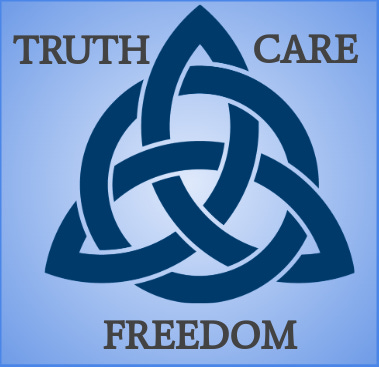Truth, Freedom, & Care (TFC) Theory
Last updated as of 10/10/2024
Follow on Facebook for more about TFC Theory inspirations.
Links to TFC sub-pages
Written for everyone:
Your Intellect, Will, and Heart and What Each One Wants (PART ONE)
Your Intellect, Will, and Heart and What Each One Wants (PART TWO)
Written for those who would like a deeper dive and heavier reading:
Theological Premises of TFC Theory - The Theology of the Person
Psychological Premises of TFC Theory - Development of the Person
Overview of TFC Theory
Written by Joseph Clem, M.Ed.
This article does not constitute professional advice or services. All opinions and commentary of the author are his own and are not endorsed by any governing bodies, licensing or certifying boards, companies, or any third-party.
What is Truth, Freedom, and Care (TFC) Theory©?
Child, adolescent, and adult psycho-spiritual development
Eight stages from conception to adulthood
Across three different areas of development in each stage – the intellect, the will, and the heart
The stages “hinge” upon truthfulness, freedom, and care as ultimate values.
Why truth, freedom, and care?
We as humans think, act, and feel with a mind, will, and heart. Our mind ultimately wants to know truth. Our will ultimately wants to act in freedom. Our heart ultimately wants to love God, others, and the self.
These values are interrelated in helping us to grow and attain inner peace, meaning, and authentic happiness and joy in our lives. More specifically, we advance in our reason, willpower, and affection for others and ourselves.
Where does this theory come from?
Originally developed in 1979 by Dr. Eduardo Azcarate, the founder of Youth Apostles and a clinical adolescent psychologist, who used this theory in his clinical practice after consultation with clergy and professionals. It is based on and influenced by:
Catholic philosophy, theology, and psychology
Secular developmental psychology, especially Erik Erikson’s psychosocial stages of development, Jean Piaget’s cognitive development, Robert Havighurst’s developmental task theory, and Virginia Satir’s change model
After its inception, the theory has been shown to be consistent with other theories (i.e., Maria Montessori’s planes of development, Sullivan’s interpersonal theory, etc.), with the philosophy of Dr. Dietrich von Hildebrand and St. John Paul II, and with the psychological premises of the seminal work of A Catholic Christian Meta-Model of the Person (CCMMP) from Divine Mercy University.
How does it work?
Each of the eight stages has three values across the intellect (reason), will (willpower or volition), and heart (affection). Each value is presented as a continuum in which a person is moving in the direction of maturation (the value) or moving in the direction of estrangement (the anti-value).
For example, awareness vs. aloofness represents the two extremes of a continuum in which awareness is a value and aloofness is an anti-value. Someone may be more aware or more aloof, but the positive resolution of each stage means that the person will end on the awareness rather than aloofness end of the continuum.
Every person is unique and complex by his or her nature as body and soul. This requires an integrated, flexible, and multi-dimensional lens through which to examine the development of the person. Although approximate ages are given for the stages of maturation, it is theorized that a person can:
Work to resolve a stage outside of the age-estimated sequence
Work to resolve two or more stages at a time, in part or in whole
Revisit an earlier stage in order to have a more complete resolution of that stage
Have an experience that disrupts a previously resolved stage
Always be working toward ultimate values of truth, freedom, and care
Have imbalances across reason, will, and affection that lead to struggles with development
Start working on a future stage sooner
Maturation vs. Estrangement Growth Chart
STAGES OF PSYCHO-SPIRITUAL DEVELOPMENT
Content for paid subscribers below:
All of the above information in one officially copyrighted PDF document, as well as
the definitions of the terms used in the Maturation vs. Estrangement Growth Chart©
the charts & diagrams listed below
The Theology of the Person© [chart]
Trichotomous Perspective of the Person© (based on the CCMMP’s dichotomous perspective) [diagram]
Inter-dynamic of Body and Spirit© [diagram]
If you are seeing content below, it is because you are a paid subscriber — thank you for your support of this ministry!
Click on this link for an officially copyrighted document of TFC Theory with Definitions of Terms.
Below are multiple visual supports to explain some of the premises. Please reach out to me via truthfreedomcaretheory@gmail.com if you would like to learn more about any of these.










